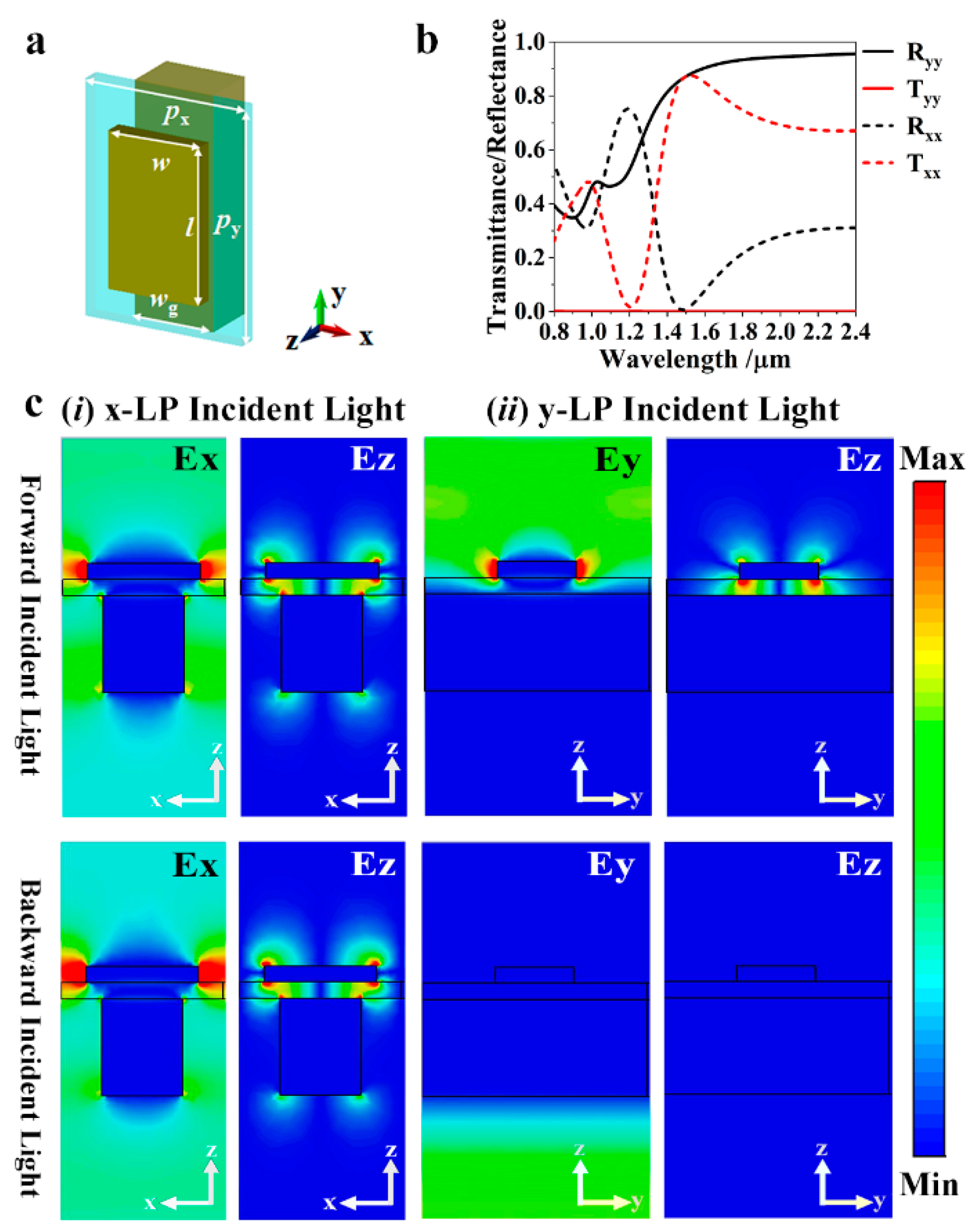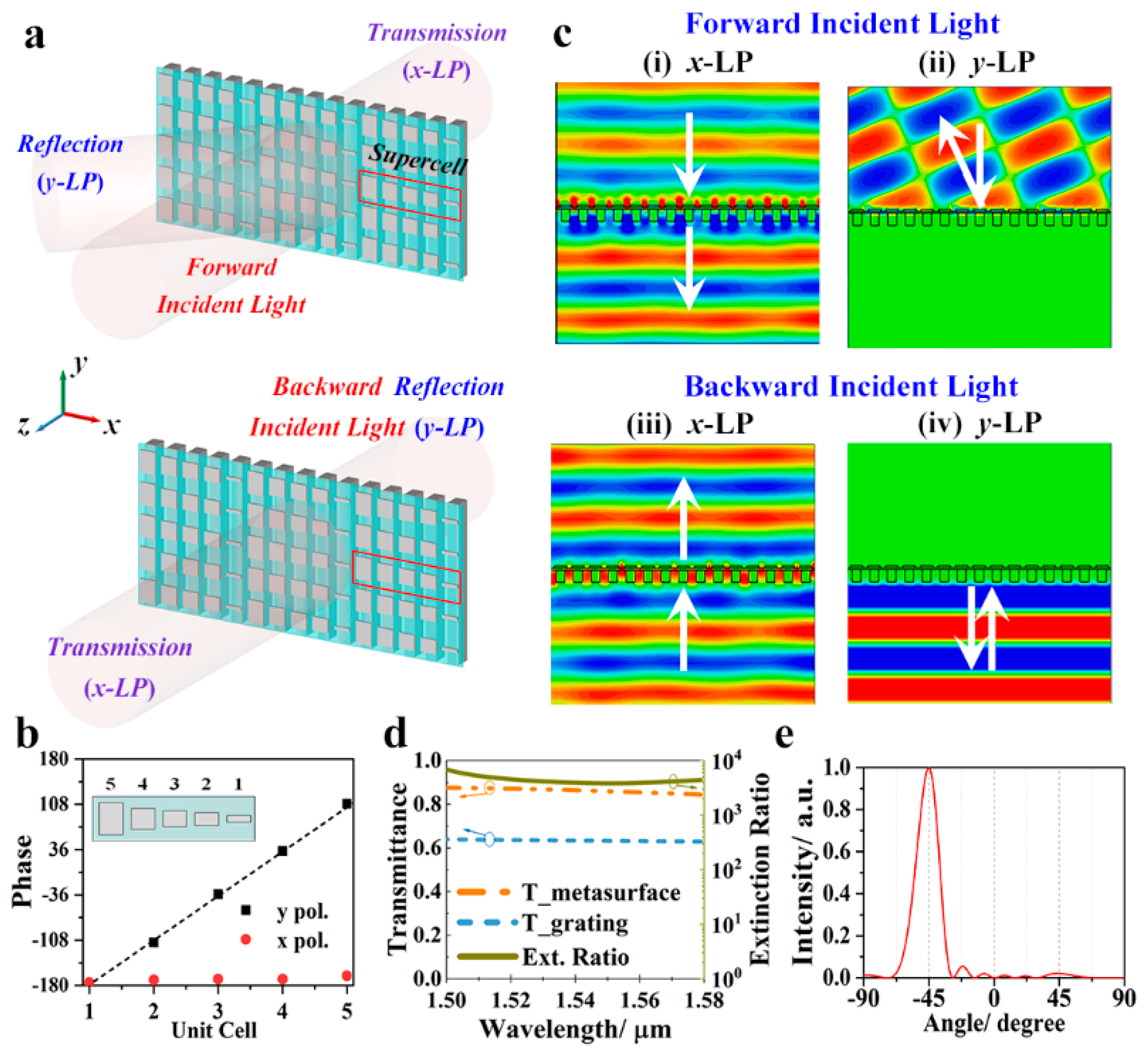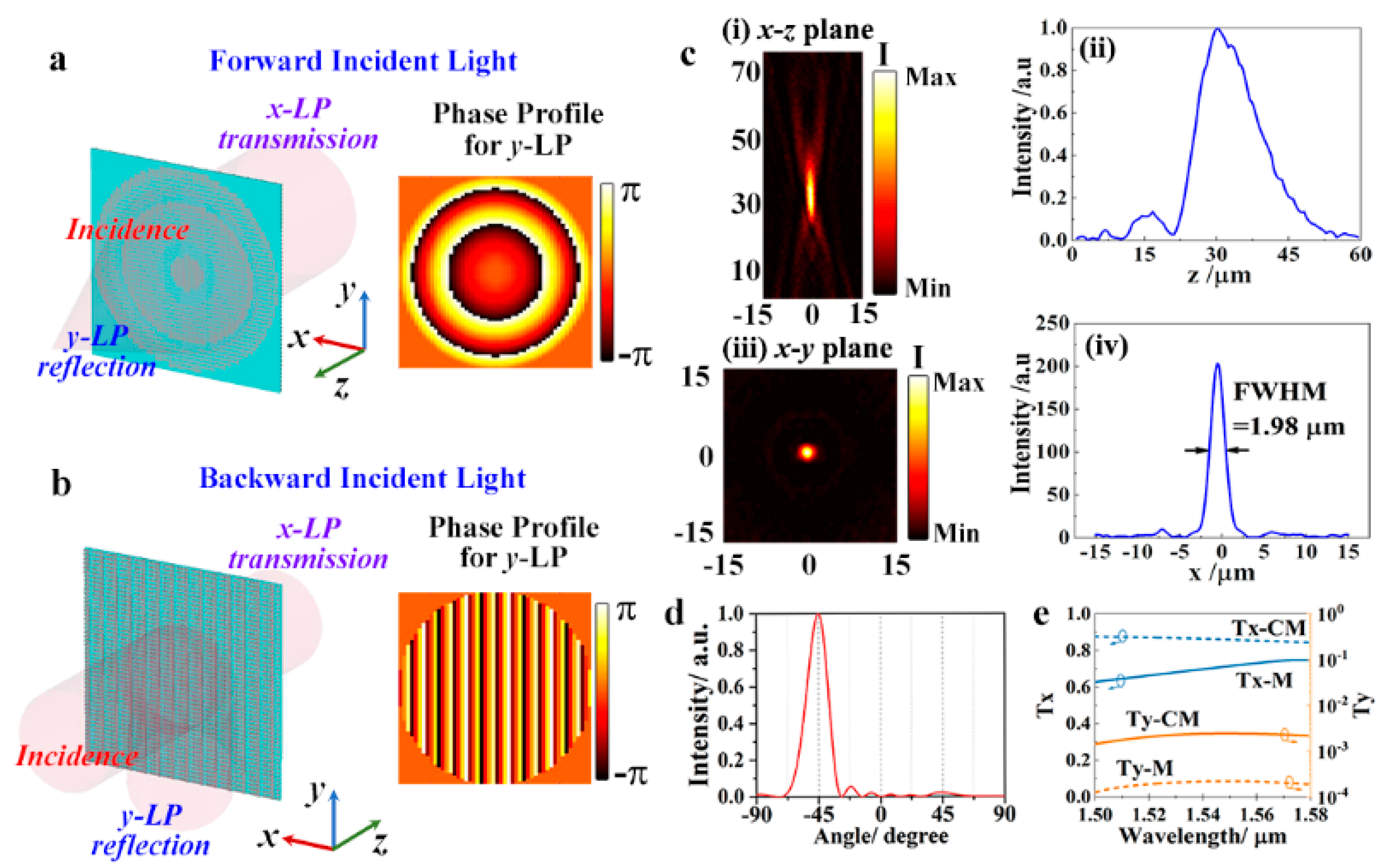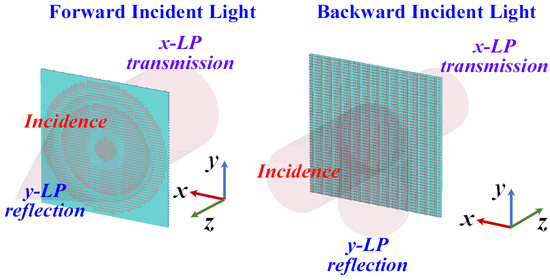Design of Multifunctional Janus Metasurface Based on Subwavelength Grating
Abstract
1. Introduction
2. Unit Cell Design
3. Janus Metasurface Based on Subwavelength Gratings
3.1. Bifunctional Janus Metasurface as a Polarizer and Deflector
3.2. Multifunctional Janus Metasurface as a Polarizer, Lens, and Deflector
4. Conclusions
Supplementary Materials
Author Contributions
Funding
Conflicts of Interest
References
- Li, X.; Tang, J.; Baine, J. Polarization-Independent Metasurface Lens Based on Binary Phase Fresnel Zone Plate. Nanomaterials 2020, 10, 1467. [Google Scholar] [CrossRef]
- Intaravanne, Y.; Chen, X. Recent advances in optical metasurfaces for polarization detection and engineered polarization profiles. Nanophotonics 2020, 9, 1003–1014. [Google Scholar] [CrossRef]
- Liu, W.; Li, Z.; Cheng, H.; Chen, S. Dielectric Resonance-Based Optical Metasurfaces: From Fundamentals to Applications. iScience 2020, 23, 101868. [Google Scholar] [CrossRef]
- Lin, R.J.; Su, V.-C.; Wang, S.; Chen, M.K.; Chung, T.L.; Chen, Y.H.; Kuo, H.Y.; Chen, J.-W.; Chen, J.; Huang, Y.-T.; et al. Achromatic metalens array for full-colour light-field imaging. Nat. Nanotechnol. 2019, 14, 227–231. [Google Scholar] [CrossRef]
- Chu, C.H.; Tseng, M.L.; Chen, J.; Wu, P.C.; Chen, Y.-H.; Wang, H.-C.; Chen, T.-Y.; Hsieh, W.T.; Wu, H.J.; Sun, G.; et al. Active dielectric metasurface based on phase-change medium. Laser Photonics Rev. 2016, 10, 986–994. [Google Scholar] [CrossRef]
- Kim, Y.; Wu, P.C.; Sokhoyan, R.; Mauser, K.; Glaudell, R.; Kafaie Shirmanesh, G.; Atwater, H.A. Phase Modulation with Electrically Tunable Vanadium Dioxide Phase-Change Metasurfaces. Nano Lett. 2019, 19, 3961–3968. [Google Scholar] [CrossRef] [PubMed]
- Yu, P.; Li, J.; Zhang, S.; Jin, Z.; Schütz, G.; Qiu, C.-W.; Hirscher, M.; Liu, N. Dynamic Janus Metasurfaces in the Visible Spectral Region. Nano Lett. 2018, 18, 4584–4589. [Google Scholar] [CrossRef]
- Li, J.; Yu, P.; Zhang, S.; Liu, N. A Reusable Metasurface Template. Nano Lett. 2020, 20, 6845–6851. [Google Scholar] [CrossRef]
- Yin, X.; Steinle, T.; Huang, L.; Taubner, T.; Wuttig, M.; Zentgraf, T.; Giessen, H. Beam switching and bifocal zoom lensing using active plasmonic metasurfaces. Light-Sci. Appl. 2017, 6, e17016. [Google Scholar] [CrossRef]
- Wen, D.; Yue, F.; Li, G.; Zheng, G.; Chan, K.; Chen, S.; Chen, M.; Li, K.F.; Wong, P.W.H.; Cheah, K.W.; et al. Helicity multiplexed broadband metasurface holograms. Nat. Commun. 2015, 6, 8241. [Google Scholar] [CrossRef]
- Mueller, J.P.; Rubin, N.; Devlin, R.; Groever, B.; Capasso, F. Metasurface Polarization Optics: Independent Phase Control of Arbitrary Orthogonal States of Polarization. Phys. Rev. Lett. 2017, 118. [Google Scholar] [CrossRef]
- Zhou, Y.; Kravchenko, I.I.; Wang, H.; Zheng, H.; Gu, G.; Valentine, J. Multifunctional metaoptics based on bilayer metasurfaces. Light-Sci. Appl. 2019, 8, 80. [Google Scholar] [CrossRef]
- de Gennes, P.-G. Soft Matter (Nobel Lecture). Angew. Chem. Int. Ed. Engl. 1992, 31, 842–845. [Google Scholar] [CrossRef]
- Faria, J.; Ruiz, M.P.; Resasco, D.E. Phase-Selective Catalysis in Emulsions Stabilized by Janus Silica-Nanoparticles. Adv. Synth. Catal. 2010, 352, 2359–2364. [Google Scholar] [CrossRef]
- Alexeev, A.; Uspal, W.; Balazs, A. Harnessing Janus Nanoparticles to Create Controllable Pores in Membranes. ACS Nano 2008, 2, 1117–1122. [Google Scholar] [CrossRef]
- Picardi, M.; Zayats, A.; Rodríguez-Fortuño, F. Janus and Huygens’ dipoles: Near-field directionality beyond spin-momentum locking. Phys. Rev. Lett. 2018, 120, 117402. [Google Scholar] [CrossRef]
- Garbuzenko, O.B.; Winkler, J.; Tomassone, M.S.; Minko, T. Biodegradable Janus Nanoparticles for Local Pulmonary Delivery of Hydrophilic and Hydrophobic Molecules to the Lungs. Langmuir 2014, 30, 12941–12949. [Google Scholar] [CrossRef]
- Chen, Y.; Yang, X.; Gao, J. 3D Janus plasmonic helical nanoapertures for polarization-encrypted data storage. Light-Sci. Appl. 2019, 8, 45. [Google Scholar] [CrossRef] [PubMed]
- Chen, K.; Ding, G.; Hu, G.; Jin, Z.; Zhao, J.; Feng, Y.; Jiang, T.; Alù, A.; Qiu, C.-W. Directional Janus Metasurface. Adv. Mater. 2020, 32, 1906352. [Google Scholar] [CrossRef] [PubMed]
- Palik, E.D. Handbook of Optical Constants of Solids of Solids; Academic Press: New York, NY, USA, 1985; pp. 369–406. [Google Scholar]
- Ding, F.; Chen, Y.; Bozhevolnyi, S.I. Focused vortex-beam generation using gap-surface plasmon metasurfaces. Nanophotonics 2020, 9, 371–378. [Google Scholar] [CrossRef]
- Lu, D.Y.; Cao, X.; Wang, K.J.; He, M.; Wang, D.; Li, J.; Zhang, X.M.; Liu, L.; Luo, J.H.; Li, Z. Broadband reflective lens in visible band based on aluminum plasmonic metasurface. Opt. Express 2018, 26, 34956. [Google Scholar] [CrossRef] [PubMed]
- Pu, M.; Chen, P.; Wang, C.; Wang, Y.; Zhao, Z.; Hu, C.; Huang, C.; Luo, X. Broadband anomalous reflection based on gradient low-Q meta-surface. AIP Adv. 2013, 3, 052136. [Google Scholar] [CrossRef]
- Yu, N.; Genevet, P.; Kats, M.A.; Aieta, F.; Tetienne, J.P.; Capasso, F.; Gaburro, Z. Light Propagation with Phase Discontinuities Reflection and Refraction. Science 2011, 334, 333–337. [Google Scholar] [CrossRef]
- Chen, X.; Huang, L.; Mühlenbernd, H.; Li, G.; Bai, B.; Tan, Q.; Jin, G.; Qiu, C.W.; Zhang, S.; Zentgraf, T. Dual-polarity plasmonic metalens for visible light. Nat. Commun. 2012, 3, 1198. [Google Scholar] [CrossRef] [PubMed]
- Devlin, R.C.; Ambrosio, A.; Rubin, N.A.; Mueller, J.P.B.; Capasso, F. Arbitrary spin-to-orbital angular momentum conversion of light. Science 2017, 358, 896–900. [Google Scholar] [CrossRef] [PubMed]
- Zhang, Z.; Wen, D.; Zhang, C.; Chen, M.; Wang, W.; Chen, S.; Chen, X. Multifunctional Light Sword Metasurface Lens. ACS Photonics 2018, 5, 1794–1799. [Google Scholar] [CrossRef]
- Ji, R.; Wang, S.W.; Liu, X.; Lu, W. Giant and broadband circular asymmetric transmission based on two cascading polarization conversion cavities. Nanoscale 2016, 8, 8189–8194. [Google Scholar] [CrossRef]
- Mayer, M.; Tebbe, M.; Kuttner, C.; Schnepf, M.J.; König, T.; Fery, A. Template-assisted colloidal self-assembly of macroscopic magnetic metasurfaces. Faraday Discuss. 2016, 191, 159–176. [Google Scholar] [CrossRef]
- Kanako, W.; Kotaro, K.; Daisuke, N. External-Stimuli-Assisted Control over Assemblies of Plasmonic Metals. Materials 2018, 11, 794. [Google Scholar]




Publisher’s Note: MDPI stays neutral with regard to jurisdictional claims in published maps and institutional affiliations. |
© 2021 by the authors. Licensee MDPI, Basel, Switzerland. This article is an open access article distributed under the terms and conditions of the Creative Commons Attribution (CC BY) license (https://creativecommons.org/licenses/by/4.0/).
Share and Cite
Ji, R.; Jin, C.; Song, K.; Wang, S.-W.; Zhao, X. Design of Multifunctional Janus Metasurface Based on Subwavelength Grating. Nanomaterials 2021, 11, 1034. https://doi.org/10.3390/nano11041034
Ji R, Jin C, Song K, Wang S-W, Zhao X. Design of Multifunctional Janus Metasurface Based on Subwavelength Grating. Nanomaterials. 2021; 11(4):1034. https://doi.org/10.3390/nano11041034
Chicago/Turabian StyleJi, Ruonan, Chuan Jin, Kun Song, Shao-Wei Wang, and Xiaopeng Zhao. 2021. "Design of Multifunctional Janus Metasurface Based on Subwavelength Grating" Nanomaterials 11, no. 4: 1034. https://doi.org/10.3390/nano11041034
APA StyleJi, R., Jin, C., Song, K., Wang, S.-W., & Zhao, X. (2021). Design of Multifunctional Janus Metasurface Based on Subwavelength Grating. Nanomaterials, 11(4), 1034. https://doi.org/10.3390/nano11041034







